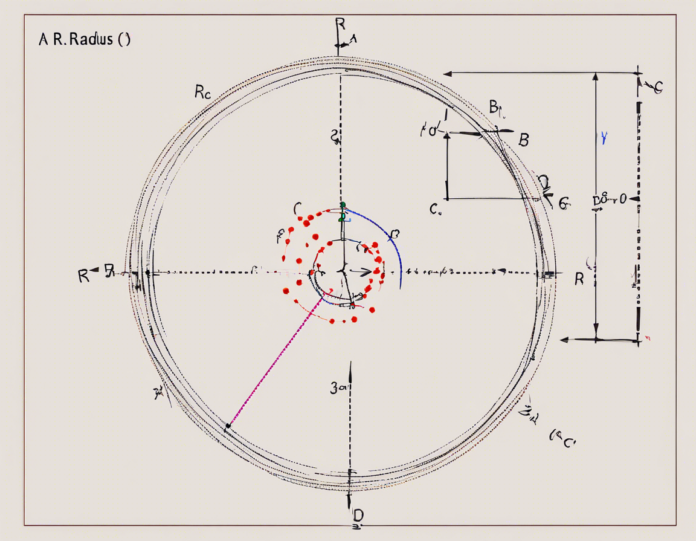Circular motion is a common occurrence in physics and everyday life. When a particle moves along the path of a circle with a constant radius R, it undergoes circular motion. This type of motion is characterized by a constant distance from a fixed point, known as the center of the circle. Understanding the dynamics of a particle moving on a radius R can provide insights into concepts like centripetal force, angular velocity, and acceleration. Let’s delve deeper into the intricacies of circular motion with a focus on a particle moving on a radius R.
Dynamics of Circular Motion
Centripetal Force
In circular motion, the centripetal force is the force that keeps an object moving in a circle. For a particle moving on a radius R, the centripetal force is given by the formula:
F_c = m * v^2 / R
Where:
– Fc is the centripetal force
– m is the mass of the particle
– v is the velocity of the particle
– R is the radius of the circle
The centripetal force acts towards the center of the circle and is essential for maintaining the circular path of the particle.
Angular Velocity
Angular velocity, represented by the symbol ω, is the rate of change of angular displacement with respect to time. For a particle moving on a radius R in a circle, the angular velocity is given by:
ω = v / R
Where:
– v is the linear velocity of the particle
– R is the radius of the circle
Angular velocity is a vector quantity and points along the axis of rotation according to the right-hand rule.
Acceleration in Circular Motion
In circular motion, the acceleration of a particle moving on a radius R consists of two components: tangential acceleration and centripetal acceleration. The total acceleration is the vector sum of these two components.
- Tangential Acceleration: The rate of change of the speed of the particle along the tangent to the circle. It is given by:
at = dv / dt
- Centripetal Acceleration: The acceleration that keeps the particle moving in a circular path. It is directed towards the center of the circle and is given by:
ac = v^2 / R
The total acceleration of the particle is the vector sum of the tangential and centripetal accelerations.
Energy Considerations
Kinetic Energy
In circular motion, the kinetic energy of a particle moving on a radius R can be described in terms of its linear velocity v:
KE = 1/2 * m * v^2
Where:
– KE is the kinetic energy
– m is the mass of the particle
– v is the velocity of the particle
The kinetic energy of the particle remains constant as long as there are no external forces acting on it.
Potential Energy
For a particle moving on a radius R in a gravitational field, the potential energy can be calculated using the formula:
PE = m * g * h
Where:
– PE is the potential energy
– m is the mass of the particle
– g is the acceleration due to gravity
– h is the height of the particle above a reference point
In circular motion, changes in potential energy can occur if the radius R or height h of the particle changes.
Uniform Circular Motion
When a particle moves on a radius R in a circular path with a constant speed, it is said to be in uniform circular motion. In this scenario, the following properties hold true:
- The magnitude of the velocity is constant.
- The direction of the velocity is constantly changing.
- The speed of the particle remains unchanged, but its direction changes continuously.
Uniform circular motion involves a balance between the centripetal force required to keep the particle moving in a circle and the inertia of the particle resisting changes in its velocity.
Frequently Asked Questions (FAQs)
Q1: What is the difference between linear velocity and angular velocity in circular motion?
A: Linear velocity refers to the speed of an object along a straight line path, while angular velocity measures the rate of rotation around a fixed point in circular motion.
Q2: How does the radius of the circle affect the centripetal force required for circular motion?
A: A smaller radius requires a greater centripetal force to keep the particle moving in a circle, as the force is inversely proportional to the radius.
Q3: Can a particle in circular motion have a constant speed but changing velocity?
A: Yes, in circular motion, the direction of the velocity constantly changes, even if the speed of the particle remains constant.
Q4: What is the relationship between angular velocity and linear velocity in circular motion?
A: Angular velocity is directly proportional to linear velocity and inversely proportional to the radius of the circle.
Q5: How does acceleration in circular motion differ from acceleration in linear motion?
A: Acceleration in circular motion involves both tangential acceleration (changes in speed) and centripetal acceleration (changes in direction), whereas linear motion mainly deals with changes in speed.
In conclusion, understanding the dynamics of a particle moving on a radius R in circular motion involves grasping concepts like centripetal force, angular velocity, and acceleration. By exploring the relationship between these quantities and considering energy considerations, one can gain a comprehensive understanding of the behavior of particles in circular paths. Whether it’s analyzing uniform circular motion or delving into the nuances of kinetic and potential energy, the study of circular motion offers a rich field for exploration and application in various scientific disciplines.

